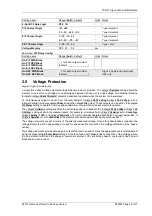
7SG11 Argus Technical Reference
©2013 Siemens Protection Devices Limited
P20007 Page 44 of 71
the CB closes onto a fault, or a fault occurs during the reclaim delay time, then the relay performs the
programmed one trip to lockout.
The relay will not issue a close pulse to a circuit breaker that is indicating that it is closed, i.e. the double
command status inputs CB Open is cleared and CB Closed is raised. If a Don’t Believe It (DBI) condition exists,
e.g. CB Open and CB Closed are both raised then the relay will issue the close pulse.
Remote Close and Reclaim
When this command is raised (edge triggered) if the CB is open the relay enables line check, then immediately
issues a defined close pulse and enters the reclaim delay. There is no delay, as for Local Close & Reclaim, since
there are tight ‘Time allowed to live’ limits on SCADA commands.
If the CB closes onto a fault, or a fault occurs during the reclaim delay time, then the relay performs the
programmed one trip to lockout.
The relay will not issue a close pulse to a circuit breaker that is indicating that it is closed, i.e. the double
command status inputs CB Open is cleared and CB Closed is raised. If a Don’t Believe It (DBI) condition exists,
e.g. CB Open and CB Closed are both raised the relay will issue the close pulse.
Trip and Auto-reclose
When this command is raised (edge triggered) the relay immediately issues a trip pulse then, after the first phase-
fault reclose delay, it enables line check then issues a close pulse to reclose the circuit breaker and enters
reclaim. If the CB closes onto a fault, or a fault develops during reclaim, then the relay will perform the line check
one trip to lockout. This command is typically used for a routine test of the Trip and Close operations of the Circuit
Breaker.
Close and Lock-in
When this command is raised (edge triggered) if the CB is open the relay immediately issues a defined close
pulse and then inhibits all Protection and Autoreclose functions. This allows the circuit breaker to be operated as
a switch without protection trip functions.
Table 2-21
Auto-reclose Commands Settings
Sub-menu:
Auto-reclose
Setting name
Range (
bold
= default)
Units Notes
Manual Close Delay
OFF
, 1, 2…10
sec
Sub-menu:
Status Config.
Setting name
Range (
bold
= default)
Units Notes
Gn Trip & ARC
Gn Close & Lockin
_, 1 for each status input
(default:
_ _ _ _ _ _ _ _ _
)
Gn Trip & Lockout
_, 1 for each status input
(default:
_ _ _ _ _ _ _ 1 _
)
Gn Local Close & Reclaim
_, 1 for each status input
(default:
_ _ _ _ _ _ _ _ 1
)
Gn Remote Close Reclaim
_, 1 for each status input
(default:
_ _ _ _ _ _ _ _ _
)
2.9.3 Frequent Operations Counter
Argus 4 & 6 relays incorporate a Frequent Operations Counter (FOC) which operates to prevent cyclical
operations caused by multiple fault re-occurrences or by setting interactions between AutoReclosers at different
points in the system in response to a permanent fault. While the FOC is exceeded it will act to truncate and
modify a sequence to break the cyclical operation. The FOC also acts to limit the number of Circuit Breaker
operations per hour to the value set by the User.
For further details see section 2.14.1.4.
2.9.4 Hot (Live) Line Working
When maintenance is being performed on an overhead line, or new equipment is being added, it can be
inconvenient or impractical to make the line dead. Live line working can be performed using special tools and
equipment. When live line working is being performed all auto-reclose sequences should be inhibited and any
fault must force an instantaneous Trip to Lockout.
















































